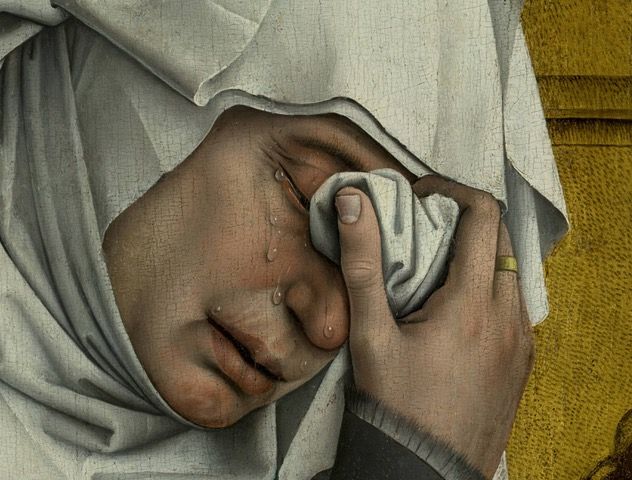The Hope of Tears

What if our tears make room for truer things?
I remember the very moment I learned I could stop my tears by pressing my tongue to the roof of my mouth when I didn’t want to cry. I was at work, and terrible reasons were being claimed for why I had gotten a recent promotion. Unwanted tears in the workplace are one thing, but the purposes of those tears are another. I didn’t understand the difference at the time, as I had learned long ago to stop any tears during embarrassing and painful moments, such as goodbyes, breakups, frustrations, and failures.
Learning to hold back my tears left me with a roaring headache, the kind that makes you feel the bigness of your eyes in their sockets. The problem with bottling up my tears of sorrow or shame also left me unable to cry at other times of beauty and awe. And over time, I was baffled and surprised by my tears and what they were designed to express.
I can name a few reasons I pushed my tears down. Tears expose places we have learned to avoid - shame, hurt, and vulnerability. They are allegedly a sign of weakness, something my 1960s childhood reinforced with its popular threat: ‘Stop crying before I give you something to cry about.’ Underneath it all lies an old Darwinian claim that tears have no purpose. In fact, tears serve many purposes and offer numerous benefits.
According to the American Academy of Ophthalmology, there are three types of tears, each having a unique purpose. All creatures have basal tears, which nourish and protect the cornea, and reflex tears, which keep the eyes washed of irritants like smoke and pollution. However, only humans have emotional tears, which release stress and express deep streams of hurt, heartache, or joy, accompanied by healing hormones and proteins.1
Allowing my own tears to flow gives me insight into my emotions long before any words take form. As I practice coming closer to my shame, heartache, and surprising joy, I am met there by deeper truths such as wisdom, companionship, beauty, and mercy. Having let my tears flow, I feel more spacious within and fresher, having been washed by them. Afterwards, I can see more clearly and welcome others authentically.
Tears have their own language, and I am learning to welcome them whenever and wherever they pool. In spiritual direction, people often apologize and wipe their tears away as quickly as possible. When I tell directees their tears are welcome, surprise and relief flash across their beautiful faces. Their spirits are trying to convey something profound and initially inexpressible. If they are willing, shedding tears, especially in the presence of another, opens our inexpressible depths to light, and once in the light, to healing and hope. Even more deeply, our vulnerability leads us to the very presence of God, where we can commune with his heart and hear the music of the spheres.
I recently heard Amy Grant say, “If I process this grief, maybe I could sing another note.”2 Her words led me to wonder if crying our tears might make room for truer things to rise, things that have been held back along with our tears? Psalmists and poets seem to know this "deep calling to deep" needs to flow for our flourishing and that of the world. The Roman poet Virgil wrote of being moved to tears – sunt lacrimae rerum – a Latin phrase that Irish poet Seamus Heaney translates as “the tears at the heart of things”.3
Franciscan priest and writer Richard Rohr suggests,
“All things have tears and all things deserve tears.
Prophets and mystics know that grief and sadness are doorways to understanding life in a non-egocentric way.”4
The truth that all things have tears and all things deserve tears is transforming my relationship with the sorrow and awe whirling deep and hot within me and in a hurting world. Our tears are a gift from the Maker of our bodies and souls, meant to express sadness, joy, delight, pain, gratefulness, repentance, longing, and awe. As we welcome the gift of tears, we learn to speak (and hear) their language. Then we can invite others to express themselves in the presence of our loving God, who sheds his own tears, mingling with ours. When we engage in an honest relationship with our tears, they become a way of knowing our truest selves, the God who loves us so tenderly, and his way in the cosmos.
I leave you with a poem by Paul Pastor,
The Hope Of Tears
We see the world with half-formed eyes and think
The world half-formed: that night falls when we blink.
Tears will wash the lens. The wise man’s light
Is salt and hot. It makes the shadow bright.
And a few questions to ask of your tears:
What could your tears wash away?
What are they expressing for yourself, the wider world, or God’s heart?
What imagination, insight or creativity might proceed from below our tears if we let them flow?
1. (Mukamal, 2025)
Bibliography:

Is a writer, spiritual director, creative space-maker, and occasional preacher. Terri has a BA in Architecture from the University of Texas at Austin and a MA in Spiritual Formation with an emphasis on Spiritual Direction from Portland Seminary. Additionally, she is a Certified Spiritual Director, also from Portland Seminary.
Terri has always been fascinated with design and the spaces that shape us. First, she explored space in physical spaces: textures, light, and materials like wood, stone, glass, and garden. Then, she was drawn to the spiritual spaces within and between us and our Artist God. In bringing the two together, we can discover delightful possibilities for the shapes of our souls.
Terri is a homebody who enjoys scenic hiking, reading, design, poetry, and writing while sipping dark roast coffee in a thrifted mug. A bunch of handpicked wildflowers in a mason jar or ironstone pitcher make her smile.

